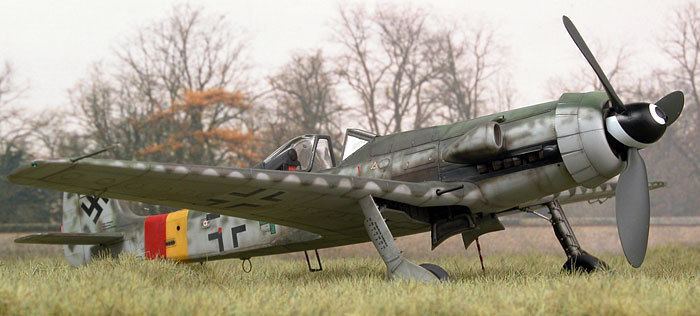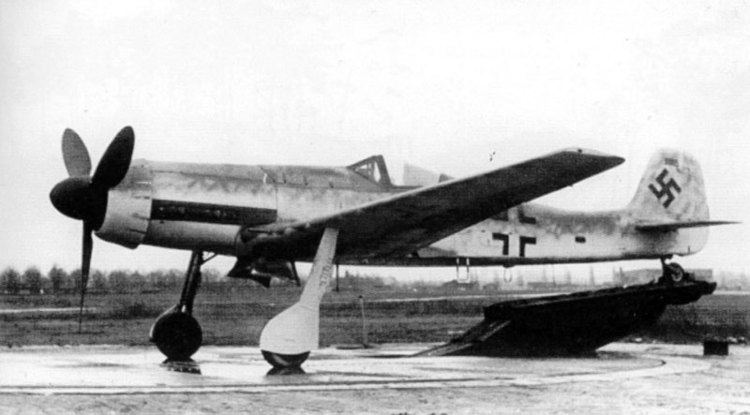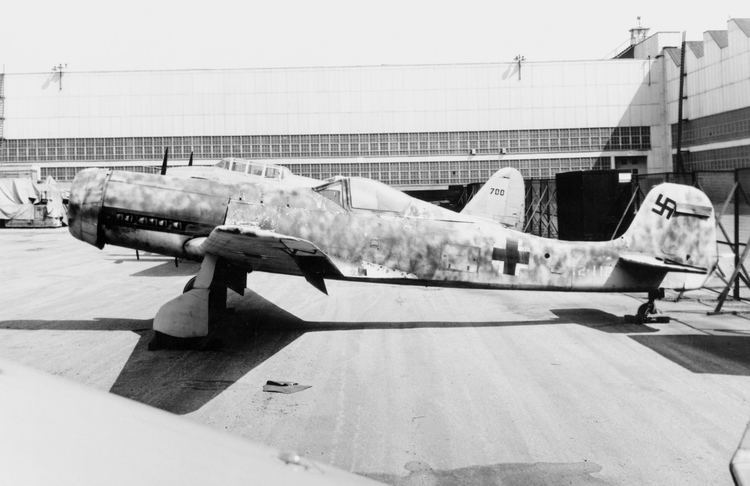Top speed 760 km/h Length 11 m Weight 3,920 kg | Wingspan 14 m Range 2,000 km | |
 | ||
Engine types Junkers Jumo 213, V12 engine | ||
Focke wulf ta 152
The Focke-Wulf Ta 152 was a World War II German high-altitude fighter-interceptor designed by Kurt Tank and produced by Focke-Wulf.
Contents
- Focke wulf ta 152
- Fw 190
- High altitude fighters
- Japanese version
- Design
- High altitude features
- Armament
- Performance
- Operational history
- Variants
- Surviving aircraft
- Operators
- Specifications Ta 152 H 1
- References
The Ta 152 was a development of the Focke-Wulf Fw 190 aircraft. It was intended to be made in at least three versions—the Ta 152H Höhenjäger ("high-altitude fighter"), the Ta 152C designed for medium-altitude operations and ground-attack using a different engine and smaller wing, and the Ta 152E fighter-reconnaissance aircraft with the engine of the H model and the wing of the C model.

The first Ta 152H entered service with the Luftwaffe in January 1945. While total production—including prototypes and pre-production aircraft—has been incorrectly estimated in one source at approximately 220 units, only some 43 production aircraft were ever delivered before the end of the European conflict. These were too few to allow the Ta 152 to make a significant impact on the air war.

Fw 190

The Fw 190's BMW 801 engine was originally designed for bomber and transport aircraft flying at medium altitudes in the 15,000 to 20,000 feet (4,600 to 6,100 m) range. In keeping with this role it used a relatively simple single-stage supercharger that lacked performance above 20,000 feet (6,100 m) altitude. This presented a problem for fighter use, where high-altitude performance was desirable. Through careful tuning, the Fw 190 instead emerged as a powerful medium altitude design. Several experimental models of the 190 with different engines were tested with improved high altitude performance, but these were not high priority projects.

The entry of the United States into the war brought with it a series of heavy bombers and escort fighters optimized for operations at higher altitudes, around 25,000 feet (7,600 m). At these altitudes, the 190 found itself at a distinct disadvantage, and this problem became acute in early 1944 when the P-51 Mustang arrived in quantity. This led to the introduction of the Fw 190D-9, mounting the Junkers Jumo 213E engine. This engine had a two-stage supercharger and much better altitude performance. However, the rest of the aircraft's design, especially the relatively short wings, made it difficult to fly at high altitudes. While the D-9 upgrade was expedient, it was not ideal.
High-altitude fighters
Rumors of the B-29, which would cruise at altitudes no German aircraft could comfortably operate at, added impetus for a dedicated high-altitude design. The Reichsluftfahrtministerium (German Air Ministry, or "RLM") requested proposals from both Focke-Wulf and Messerschmitt for a high-altitude interceptor. Messerschmitt answered with the Bf 109H, and Focke-Wulf entered a range of designs; the Fw 190 Raffat-1 (Ra-1) fighter would replace the existing 190D series, the Ra-2 was a dedicated high altitude fighter, and the Ra-3 was a ground-attack aircraft.
These designs developed into the Fw 190 V20 (Ta 152A), V21 (Ta 152B) and V30 (Ta 152H) prototypes, all based on the 190D-9 but with varying degrees of improvement. The V20 used the same Jumo 213E engine as the Fw 190D-9, while the V21 used the DB 603E. Neither of these offered any significant improvement over the 190D-9, and further development of the Ta 152A and B was canceled. The V21 airframe, however, was further modified as the V21/U1 and became the prototype for the Ta 152C.
Japanese version
The IJAAF acquired, in April 1945, the license, schemes and technical drawings for manufacturing the Ta 152 in Japan. During the last stages of the conflict in Germany, with the plight of the Japanese armed forces growing ever bleaker, a large volume of the latest aviation technology Germany had to offer was given to or bought by both the Japanese army and naval air arms in the hopes that it would stem the tide of defeats and ever increasing pressure by the vast numbers of aircraft the Allies were putting into the field.
Design
Kurt Tank originally designed the Ta 152 using the 44.52 litre displacement Daimler-Benz DB 603 engine as it offered better high-altitude performance and also a greater developmental potential. The DB 603 had been used in the Fw 190C prototypes but had many problems and was considered too difficult to implement in the Ta 152 by RLM officials. With this in mind, Tank focused his efforts on the 213E as the Ta 152H's power plant. However, he insisted that the DB 603 be retained for the Ta 152C versions and as an option for later versions of the Ta 152H.
The Ta 152's fuselage was an extended version of the Fw 190D-9 fuselage with wider-chord fixed vertical tail surfaces (especially the top half), and hydraulic rather than electrically controlled undercarriage and flaps. Due to the changes in the center of gravity and overall balance, the nose was also lengthened. The D-9 retained the 10.51 metres (34.5 ft) wingspan of the original pre-war Fw 190 models, but this was slightly extended for the C model to 11 metres (36 ft), and greatly extended for the H model to 14.44 metres (47.4 ft), which gave it much better control at high altitudes at the cost of speed at lower altitudes.
Due to the war's impact on aluminum availability, the wing was built around two steel spars, the front extending from just past the landing gear attachment points, and the rear spar spanning the entire wing. The wing itself was designed with 3° of washout, from the root to the flap-aileron junction, to prevent the ailerons from stalling before the center section of the wing.
The Ta 152 also featured the FuG 16ZY and FuG 25a radio equipment (some aircraft were issued with FuG 125 Hermine D/F for navigation and blind landing, LGW-Siemens K 23 autopilot, and a heated armor glass windscreen for bad-weather operations).
High-altitude features
To reach higher altitudes, a pressurized cockpit was added to the H models. The canopy was sealed via a circular tube filled with rubber foam which was inflated by a compressed air bottle, while the engine compartment was also sealed from the cockpit with a rubber foam ring. A Knorr 300/10 air compressor provided the pressure, maintaining the cockpit at 0.36 atmospheres (5.29 psi) above 8,000 m (26,250 ft). To prevent fogging, the windscreen was of a double-glazed style with a 6 mm (.236 in) thick outer pane and a 3 mm (.118 in) inner pane with a 6 mm (.24 in) gap. The gap was fitted with several silica gel capsules to absorb any moisture forming between the panes. The cockpit was not pressurized in the C models.
Armament
The H model had heavy armament to allow it to deal quickly with enemy aircraft. It had three weapons: one 30 mm (1.18 in) MK 108 Motorkanone cannon centered within the propeller hub and two 20 mm MG 151/20 cannons, synchronized to fire through the propeller, located in the wing roots.
The C model was designed to operate at lower altitudes than the H-model with the same armament package, while adding two more of the MG 151/20 cannon, likewise synchronized as these additional autocannon for the C-model were mounted just ahead of the windscreen, and above the engine's upper rear crankcase. The Ta 152C could destroy the heaviest enemy bombers with a short burst but the added weight decreased speed and rate of turn.
Performance
The Ta 152H-1 was among the fastest piston-engined fighters of the war, with a top speed comparable to the twin-engined Dornier Do 335. It was capable of 755 kilometres per hour (469 mph) at 13,500 metres (44,300 ft) using the GM-1 nitrous oxide boost and 560 kilometres per hour (350 mph) at sea level using the MW 50 methanol-water boost. It used the MW 50 system mainly for altitudes up to about 10,000 metres (33,000 ft) and the GM-1 system for higher altitudes, although both systems could be engaged at the same time.
Kurt Tank was flying an unarmed Ta 152H in late 1944 to a meeting at the Focke-Wulf plant in Cottbus when ground controllers warned him of two P-51 Mustangs. The enemy aircraft appeared behind Tank, but he escaped by applying full power and engaging the MW 50 boost "until they were no more than two dots on the horizon".
Operational history
By October 1944, the war was going very badly for Germany, and the RLM pushed Focke-Wulf to quickly get the Ta 152 into production. As a result, several Ta 152 prototypes crashed early into the test program. It was found that critical systems were lacking sufficient quality control. Problems arose with superchargers, pressurized cockpits leaked, the engine cooling system was unreliable at best due in part to unreliable oil temperature monitoring, and in several instances the landing gear failed to properly retract. A total of up to 20 pre-production Ta 152 H-0s were delivered from November 1944 to Erprobungskommando Ta 152 to service test the aircraft. It was reported that test pilots were able to conduct a mere 31 hours of flight tests before full production started. By the end of January 1945, only 50 hours or so had been completed.
III./Jagdgeschwader 301, initially a Luftwaffe Wilde Sau unit, was ordered to convert to the type in January 1945, which it did (and flew them operationally for a short time). In the end, available Ta 152s were pooled in a special Stabstaffel JG 301, first based at Alteno Air Base near Luckau, then at Neustadt-Glewe in Mecklenburg. The Stabstaffel never had more than 15 Ta 152Hs available, both H-0s and H-1s. Since the usual transfer system had broken down, replacement parts became nearly impossible to obtain.
An early Ta 152 combat occurred on 14 April 1945 when Oberfeldwebel Willi Reschke tried to intercept a De Havilland Mosquito over Stendal, but failed to catch up due to engine trouble. On the evening of that same day, Reschke was to demonstrate that the Ta 152H could be used as a low altitude fighter. A section of four Hawker Tempest Vs of 486 (NZ) Squadron were out on patrol. After attacking a train near Ludwigslust, the section split up into pairs; Wing Commander Brooker ordered the Tempests flown by Flying Officer S. J. Short and Warrant Officer Owen J. Mitchell to make their own way back to base. On the way back, this pair, which was strafing targets along the railway tracks near Ludwigslust, was spotted by lookouts posted at Neustadt-Glewe. Three Ta 152s—flown by Reschke, Oberstleutnant Aufhammer and Oberfeldwebel Sepp Sattler—were scrambled, catching the Tempests by surprise. Reschke recalled:
We reached the position at an altitude of 200 metres, just at the moment when both Tempests after diving started climbing again. Just as the dogfight was developing Sepp Sattler, on our side, was hit and his plane fell like a stone out of the sky ... The Tempest which I attacked quickly reached the same height as me and was [at] approximately 10 o'clock before me. The dogfight began between 50 and 100 metres above ground level and very often the wing tips passed close over the treetops ... The whole fight was executed in a left-hand turn, the low altitude of which would not allow for any mistakes. Ever so gradually I gained metre-by-metre on the Tempest and after a few circles, I had reached the most favourable shooting position ... I pressed my machine gun buttons for the first time ... I could see the Tempest for a short moment in straight ahead flight displaying slightly erratic flying behaviour. But immediately she went straight back into the left turn ... I sighted the Tempest very favourably in my cross hairs and could not have missed, but my machine guns experienced feeding problems. I therefore tried to shoot it down with my cannon and forced her into a tight left-hand turn from where she tipped out over her right wing and crashed into a forest.
(A more detailed and slightly different account of this incident, also by Reschke, is given in 'Fw190 Aces on the Attack' published by Osprey)
Warrant Officer Owen J. Mitchell (a pilot with only a month and half of experience on the front line) was flying the Tempest and was killed on impact with the ground. It is thought that Sattler was shot down either by Short or Bill Shaw of 486 Sqn, who claimed a Bf 109 in the same area - the Ta 152s were mistaken for 109s. Operational missions were flown in April 1945 from Neustadt, mostly escorting close support aircraft to the Battle of Berlin. Reschke claimed two Yakovlev Yak-9s near Berlin on 24 April. It seems that three often reported victory claims by Obfw. Walter Loos, on 24, 25 and 30 April, cannot be attributed to Ta 152.) Loos himself stated he never shot down a single enemy fighter while flying the Ta 152.).
The Ta 152 score at the end of the war was likely seven victories and four losses in air combat, although a degree of uncertainty about those numbers exists. Four victories were achieved by Josef Keil, from 1 March 1945 to 21 April 1945. The Ta 152 was delivered to JG 301 on 27 February 1945 and the first Ta 152 combat action against American bombers happened on 2 March 1945, so his victory against a B-17 on 20 February 1945 could not have been achieved flying that type of fighter. Alternatively, this results from an incorrect reading of published sources such as Lowe because JG 301 had the Ta 152 in service from late January 1945 and individual missions such as Keil's could well have been flown. At least three victories were achieved by Willi Reschke.
The four losses in air combat were: Hptm. Hermann Stahl, killed on 11 April 1945; Obfw. Sepp Sattler, killed on 14 April 1945; two unknown JG11 pilots, downed by Spitfires in the last days of April 1945 during transfer from Neustadt-Glewe to Leck airfield.
The total number of Ta 152 aircraft produced is unknown, but 43 have been identified in addition to about six prototypes. By February 1945, all Ta 152 production had ceased.
Variants
Surviving aircraft
There is only one surviving Ta 152, a 152 H-0 variant flown by III./Jagdgeschwader 301, a Luftwaffe Wilde Sau unit. The aircraft is housed at the National Air and Space Museum Paul E. Garber Preservation, Restoration, and Storage Facility in Suitland, Maryland, United States, where it is expected to be restored.
The aircraft is believed to be Werk-Nummer (serial number) 150020, which was a pre-production H-0 model transitioning to full production Ta 152H-1 series aircraft. It was probably built at Focke-Wulf's production facility at Cottbus, Germany, in December 1944, and delivered to Erprobungskommando Ta 152 at Rechlin, Germany, for service testing.
Operators
Specifications (Ta 152 H-1)
Data from
General characteristics
Performance
Armament
